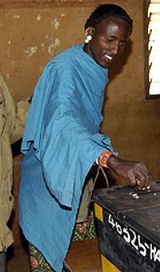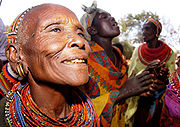
Borana
Encyclopedia
- Borana is also an alternate Spanish name of the Boran sub-family of the larger Witotoan language family.
The Borana Oromo, also called the Boran, are a pastoralist
Pastoralism
Pastoralism or pastoral farming is the branch of agriculture concerned with the raising of livestock. It is animal husbandry: the care, tending and use of animals such as camels, goats, cattle, yaks, llamas, and sheep. It may have a mobile aspect, moving the herds in search of fresh pasture and...
ethnic group living in southern Ethiopia
Ethiopia
Ethiopia , officially known as the Federal Democratic Republic of Ethiopia, is a country located in the Horn of Africa. It is the second-most populous nation in Africa, with over 82 million inhabitants, and the tenth-largest by area, occupying 1,100,000 km2...
(Oromia) and northern Kenya
Kenya
Kenya , officially known as the Republic of Kenya, is a country in East Africa that lies on the equator, with the Indian Ocean to its south-east...
. They are a moiety of the Oromo people
Oromo people
The Oromo are an ethnic group found in Ethiopia, northern Kenya, .and parts of Somalia. With 30 million members, they constitute the single largest ethnic group in Ethiopia and approximately 34.49% of the population according to the 2007 census...
, the other being the Barentu Oromo.
Profile
Oromos in northern Kenya first entered the region from southern Ethiopia during a major migratory expansion in the late 10th century. They then differentiated into the cattle-keeping Borana and the camel-keeping Gabbra and SakuyeSakuye
The Sakuye or Saguye are a semi-nomadic people living in Marsabit and Isiolo districts, Eastern Province, Kenya. The 1979 Kenyan census reported this group had 1,824 persons, but Günther Schlee believes this number "is definitely too low. The 1969 census gave 4,369 as their number, and the...
.
The Borana speak Borana
Borana language
Borana is a variety of Oromo spoken in Southern Ethiopia and northern Kenya by the Borana people. Günther Schlee also notes that it is the native language of a number of related peoples, such as the Sakuye....
(or afaani Boraana), which is part of the Cushitic
Cushitic languages
The Cushitic languages are a branch of the Afroasiatic language family spoken in the Horn of Africa, Tanzania, Kenya, Sudan and Egypt. They are named after the Biblical character Cush, who was identified as an ancestor of the speakers of these specific languages as early as AD 947...
branch of the Afro-Asiatic
Afro-Asiatic languages
The Afroasiatic languages , also known as Hamito-Semitic, constitute one of the world's largest language families, with about 375 living languages...
family of languages. Roughly over 7 million people identify as Boranas.
Borana calendar
It is believed that the Borana developed their own calendar around 300 BC. The Borana calendar is a lunar-stellar calendrical system, relying on astronomical observations of the moon in conjunction with seven particular stars or constellations. Borana Months (Stars/Lunar Phases) are Bittottessa (iangulum), Camsa (Pleiades), Bufa (Aldebarran), Waxabajjii (Belletrix), Obora Gudda (Central Orion-Saiph), Obora Dikka (Sirius), Birra (full moon), Cikawa (gibbous moon), Sadasaa (quarter moon), Abrasa (large crescent), Ammaji (medium crescent), and Gurrandala (small crescent).Sub-groups

Oromo people
The Oromo are an ethnic group found in Ethiopia, northern Kenya, .and parts of Somalia. With 30 million members, they constitute the single largest ethnic group in Ethiopia and approximately 34.49% of the population according to the 2007 census...
are divided into two major branches that break down into an assortment of clan families. From west to east and north to south, these subgroups are as listed:
The Borana which include:
- The Maccaa Oromo, living between Didessa River and the Omo RiverOmo RiverThe Omo River is an important river of southern Ethiopia. Its course is entirely contained within the boundaries of Ethiopia, and empties into Lake Turkana on the border with Kenya...
, and south into the Gibe regionGibe regionThe Gibe region is used to indicate a historic region in modern southwestern Ethiopia, to the west of the Gibe and Omo Rivers, and north of the Gojeb...
; - The Tulama Oromo, who live in the Oromia Region around Addis AbabaAddis AbabaAddis Ababa is the capital city of Ethiopia...
; - The Guji OromoGuji OromoThe Guji Oromo are an ethnic Oromo group living in southern Ethiopia. They are part nomadic and part agrarian. According to a population projection from 2007, the total population of the Guji Oromo is above 5 million....
, who are the southern part subgroup of the Oromo, inhabiting neighboring the Garri (Gharri) and Borana Oromo. - The Borana Oromo who live in the Borena ZoneBorena ZoneBorena is one of the 17 zones of the Oromia Region of Ethiopia. Borena is named after a tribe of the Oromo people. Borena is bordered on the south by Kenya, on the west by the Southern Nations, Nationalities, and Peoples Region, on the north by Guji and on the east by the Somali Region. The...
, which includes MoyaleMoyaleMoyale is a market town on the border of Ethiopia and Kenya, which is split between the two countries: the larger portion is in Ethiopia , and the smaller is in Kenya . There are four disputed locations within the Moyale district between the Somali and Oromo regions...
. They also live in Kenya and parts of Somalia. - The Gabra Oromo, who live in north Kenya along the Moyale border GarriGarriGarri is a popular West African food made from cassava tubers. The spelling 'garri' is mainly used in Nigeria, Cameroon, Sierra Leone and 'gari' in Ghana....
, (Gharri) region, who live in north east Kenya and parts of Somalia
And countless subdivisions.
Further reading
- Asmerom Legesse, Gada
- Beckingham and G.W.B. Huntingford, Some records of Ethiopia Hakluyt Society, 1954
- Bassi Marco, Decisions in the Shade. Political and juridical processes among the Oromo-Borana Red Sea Press, 2005
- Clifford H F Plowman CMG OBE, Notes On The Gedamoch Ceremonies Among The Boran, (Journal of the Royal African Society, Vol. 18, No. 70 (Jan., 1919), pp. 114-121 )

